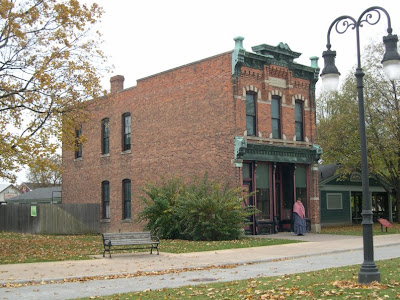Whittier Tollhouse & Shoeshop a.k.a Rocks Village Tollhouse and Shoe Shop
 Along the gray abutment's wall
Along the gray abutment's wallThe idle shad-net dries;
The toll-man in his cobbler's stall
Sits smoking with closed eyes.
You hear the pier's low undertone
Of waves that chafe and gnaw;
You start,--a skipper's horn is blown
To raise the creaking draw.
(verses 5 and 6 from "The Countess" by John Greenleaf Whittier 1863)
John Whittier, the author of the above poem, lived just four miles from where this structure originally stood.
The tiny, seemingly insignificant shack, which served as the toll keeper's stall, was built in 1828 in Rocks Village, East Haverhill (pronounced HAY-vruhl ), Massachusetts, on the banks of the Merrimac River, near a draw bridge that connected the towns of East Haverhill and West Newbury. The one room building was erected after the original crossing bridge was swept away in a storm in 1818. For ten years a ferry was used to cross the river until a new bridge was built. This building's purpose was for collecting tolls from those who crossed the bridge at this part of the river.
 There was little traffic on the river, and the keeper, having plenty of time on his hands, installed shoe making equipment to make and repair shoes. Each tollkeeper that worked in this tollhouse made the cobbler shop his spare time occupation.
There was little traffic on the river, and the keeper, having plenty of time on his hands, installed shoe making equipment to make and repair shoes. Each tollkeeper that worked in this tollhouse made the cobbler shop his spare time occupation.The building was used as a tollhouse until 1868 when all the highways in Essex County, Massachusetts were declared to be free. The amount of money in the tollhouse during the last week of its use was twenty nine dollars.
When the bridge it served was torn down in 1911, this unique building was moved to a former bridge tender's backyard.
 Ford had the 10 foot by 12 foot tollhouse shipped to Greenfield Village in 1928.The dual function as tollhouse and shoemaker continued in Greenfield Village for years as Henry Ford had a craftsman in the shop making shoes for a number of years.
Ford had the 10 foot by 12 foot tollhouse shipped to Greenfield Village in 1928.The dual function as tollhouse and shoemaker continued in Greenfield Village for years as Henry Ford had a craftsman in the shop making shoes for a number of years. Today, it once more stands at the foot of another bridge, the Ackley Covered Bridge, seen in the background of the picture below.
Today, it once more stands at the foot of another bridge, the Ackley Covered Bridge, seen in the background of the picture below.By the way, note the prices of the toll on the sign on the side of the building (click on the photo to enlarge it).
 Knowing that a well-known poem was written on its behalf gives one a reason to stop, look inside its windows, and have a greater understanding of 19th century America.
Knowing that a well-known poem was written on its behalf gives one a reason to stop, look inside its windows, and have a greater understanding of 19th century America.Although a minor footnote in American history - they are rarely mentioned in history books - tollhouses like this were commonplace on the roads of America in the early days of this country.
.



Comments